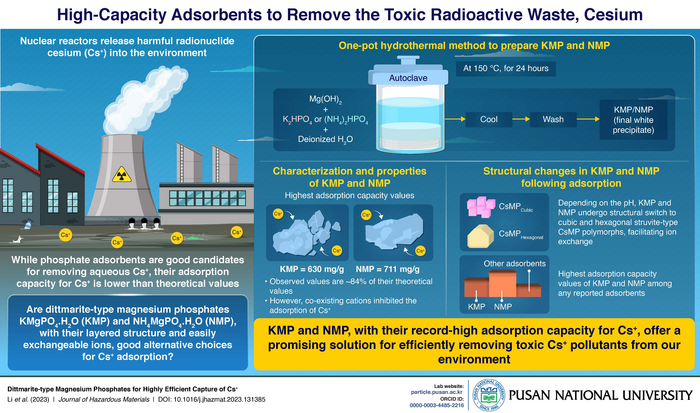Nuclear energy is crucial for producing cleaner energy, but the associated radioactive pollution requires strategic solutions. Cesium (Cs+) is a toxic radionuclide generated from nuclear power plants that demands immobilization and high adsorption methods to prevent environmental pollution. Although phosphate-based adsorbents are excellent candidates for cleanup, their inefficient ion exchange leads to limited adsorption capacity. The high theoretical adsorption of phosphate adsorbents does not match their experimental adsorption capacities.

Credit: Prof. Kuk Cho from Pusan National University
Nuclear energy is crucial for producing cleaner energy, but the associated radioactive pollution requires strategic solutions. Cesium (Cs+) is a toxic radionuclide generated from nuclear power plants that demands immobilization and high adsorption methods to prevent environmental pollution. Although phosphate-based adsorbents are excellent candidates for cleanup, their inefficient ion exchange leads to limited adsorption capacity. The high theoretical adsorption of phosphate adsorbents does not match their experimental adsorption capacities.
To remove harmful Cs+ from radioactive wastewater, Pusan National University researchers led by Professor Kuk Cho from the Department of Environmental Engineering have synthesized dittmarite-type phosphates with a layered structure, ideal for easy ion exchange. The team found that their magnesium phosphates had record-high adsorption capacities for Cs+, surpassing standard adsorbents due to exchangeable ions and dissolution-precipitation. Prof. Cho surmises, “The presence of exchangeable ions and dissolution-precipitation enabled record-high adsorption capacities for Cs+ that are higher than those of standard adsorbents.”
The study, which was made available online on April 7, 2023, will be published in Volume 453 of the Journal of Hazardous Materials on 5 July 2023. Using a one-pot hydrothermal method, the team synthesized KMgPO4⋅H2O (KMP) and NH4MgPO4⋅H2O (NMP), both of which are dittmarite-type compounds, having a high theoretical adsorption capacity of 754 mg g− 1 and 856 mg g− 1 for Cs+, respectively. The synthesized KMP and NMP had remarkable adsorption capacities of 630 mg g−1 and 711 mg g−1, respectively, which were 84% of their theoretical adsorption capacities. These experimentally measured adsorption capacity values are the highest among all reported adsorbents for Cs+.
Next, the team characterized and analyzed the physical and chemical properties of the phosphates. Based on the Cs+ adsorption performance of KMP and NMP, they showed that these phosphates are not best suited for use in water with high divalent ion concentrations. However, they can still be used in Cs+ readsorption processes, following desorption processes, to concentrate Cs+ and reduce waste volume. Emphasizing the importance of this, Prof. Cho says, “Cs+ is a popular radionuclide generated from nuclear power plants, and the volume of its waste must be minimized for disposal. To minimize the volume, the adsorbent with higher adsorption capacity is advantageous.”
The study found that the new phosphates efficiently adsorb Cs+, providing a cost-effective method for radioactive waste disposal. This is particularly important in a world where nuclear power plants are expected to increase in number, and proper storage with appropriate adsorbents will become crucial for sustainability.
In conclusion, the high adsorption capacities and stability of the synthesized phosphates make them promising candidates to deal with the radioactive waste disposal challenge.
***
Reference
DOI: https://doi.org/10.1016/j.jhazmat.2023.131385
Authors: Zeqiu Li, Chenyang Yang, and Kuk Cho
Affiliations: Department of Environmental Engineering, Pusan National University, Geumjeong-gu, Busan, Republic of Korea
*Corresponding author Professor Kuk Cho’s email: [email protected]
About Pusan National University
Pusan National University, located in Busan, South Korea, was founded in 1946, and is now the no. 1 national university of South Korea in research and educational competency. The multi-campus university also has other smaller campuses in Yangsan, Miryang, and Ami. The university prides itself on the principles of truth, freedom, and service, and has approximately 30,000 students, 1200 professors, and 750 faculty members. The university is composed of 14 colleges (schools) and one independent division, with 103 departments in all.
Website: https://www.pusan.ac.kr/eng/Main.do
About the author
Prof. Kuk Cho is a Professor of Environmental Engineering at the Pusan National University. His group is developing approaches to separate metal ions including radionuclides and heavy metals from water through designing functional materials. His group also focuses on the toxicity of atmospheric particulate matter. Before joining Pusan National University, he completed his postdoctoral training at University of Maryland, College Park. In 2005, Prof. Cho received a PhD in Environmental Engineering from Washington University in St. Louis.
Journal
Journal of Hazardous Materials
DOI
10.1016/j.jhazmat.2023.131385
Method of Research
Experimental study
Subject of Research
Not applicable
Article Title
Dittmarite-type magnesium phosphates for highly efficient capture of Cs+
Article Publication Date
7-Apr-2023
COI Statement
The authors declare no competing interests.




